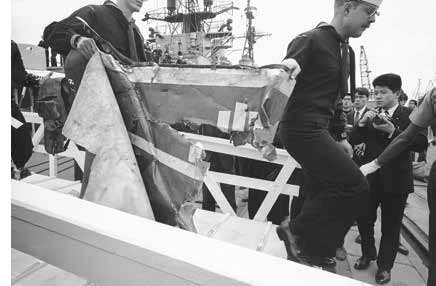Issue:
If recent events have given you a feeling of deja vu, perhaps there’s a good reason for it.
When we targeted North Korea

RECENT HEADLINES SUGGEST THAT the United States is considering a range of “options” to curb North Korea’s nuclear weapons/missiles ambitions, up to and including air strikes. What everyone seems to have forgotten is that there was a moment between the two countries in the past that also involved the planning of an air attack by the U.S. Though it eventually never took place, it’s not as easy for me to forget, as I was personally involved.
There was nothing to indicate that the day April 15, 1969, would be any different from any other day as winter gave way to cherry blossom season in Japan. I was a young air force lieutenant stationed with the 347th Fighter Wing at Yokota air base as an intelligence officer for a squadron of F-4 Phantoms.
I began my daily routine by stopping by the communications shop to pick up the morning “flemsies,” a military version of teletype print outs. From them I would construct a short briefing for the benefit of what was grandly called the “battle staff.”
On that particular morning there was no indication that anything out of the ordinary was taking place. There was the usual complement of war news from “down south,” meaning Vietnam and Cambodia, where the war was still going strong, and some information on deployment of Russian fighters in the Far East.
As I entered the War Room to give the 7 a.m. briefing, I could see immediately that something was different. The room consisted of a bank of seats culminating at the top dais where the wing commander and his deputy sat, and people usually slowly drifted in. But this day every seat was occupied and, it seemed, every eye was on me. I went over to a major sitting in the corner, and bent down to ask him what was going on.
“North Korean jets shot down one of our planes,” he said.
“Oh,” I said. I stood up and turned to face the briefing audience, fully aware that as I repeated what he had just told me, I was probably the last in the room to know. So I added, optimistically, “We’ll provide more information when we get it.”
That is how I learned about what could have become a seminal event of the Cold War in Asia. Two North Korean MiG-21s ambushed and shot down a U.S. Navy EC-121 electronic surveillance aircraft with the loss of all her crew of 31 sailors and marines over the Sea of Japan.
Within in an hour I was ordered to grab my kit and we were hustled aboard a C-130 transport plane and flown from Yokota to Osan Air Force Base in South Korea, the advance base for our wing of jet fighters. For the next week we were on a war footing, fully expecting to launch air strikes on North Korea. I still remember our target: Pukchangni air base north of the capital, Pyongyang. It is still an important North Korean Air Force base, home for MiG-23 and MiG-29 fighters.
Everyone was on edge. Pilots, who usually could barely conceal their boredom on our briefings, suddenly became very attentive to what we had to say about defenses they might encounter on bombing runs. We pulled together maps and photos and anything else we could find out about Pukchangni in order to make target folders. There wasn’t much we could do, considering how skillfully the North concealed its assets, including placing many aircraft safely in underground bunkers.
But after a week of fevered activity we were ordered to stand down. No airstrikes were ordered, and I returned to the comforts of Japan able to enjoy the cherry blossoms instead of enduring the tag end of a cold Korean winter.
This was former President Richard Nixon’s first real crisis, coming about three months after he was sworn in, or roughly the same time frame President Donald Trump sits in today. Nixon and his advisors considered several responses, including air strikes on North Korean military facilities. After debating various options, he decided against retaliatory air strikes. Presumably, he believed that one war at a time was enough.
Instead, he dispatched a small armada of war ships, built around several aircraft carriers, into the Sea of Japan as a show of force very much like the flotilla sent into the region by Trump. But after a time, they departed and Nixon simply ordered the reconnaissance flights to resume, albeit escorted by fighters.
He faced the same conundrum that bedevils policy makers to this day: namely, what kind of force could the U.S. use that would be tough enough to punish North Korea but not so tough that Pyongyang would think it was prelude to a general invasion, requiring a massive retaliation? Remember, this was a time when nuclear weapons were only a gleam in the eye of supreme leader Kim Il-sung.
The EC-121 shoot down was the single largest loss of U.S. aircrew during the Cold War. There is no memorial to the crew, but the U.S. Navy detachment at Misawa Air Force Base places a floral wreath on the edge of the Sea of Japan and watches it drift out to sea. They have been doing this every April 15 for 47 years.
Todd Crowell is the author of The Coming War Between China and Japan published as an Amazon Single Kindle.

